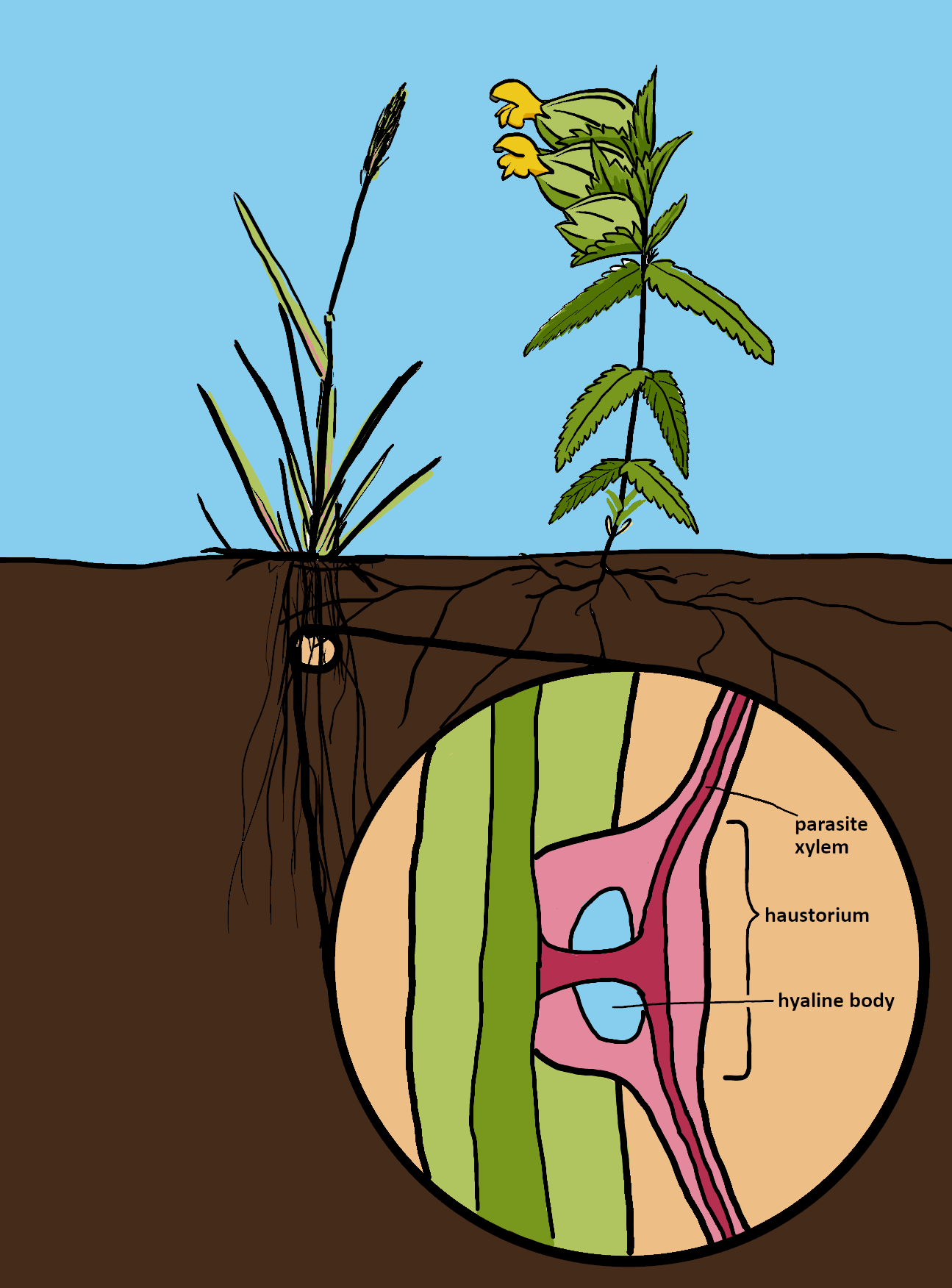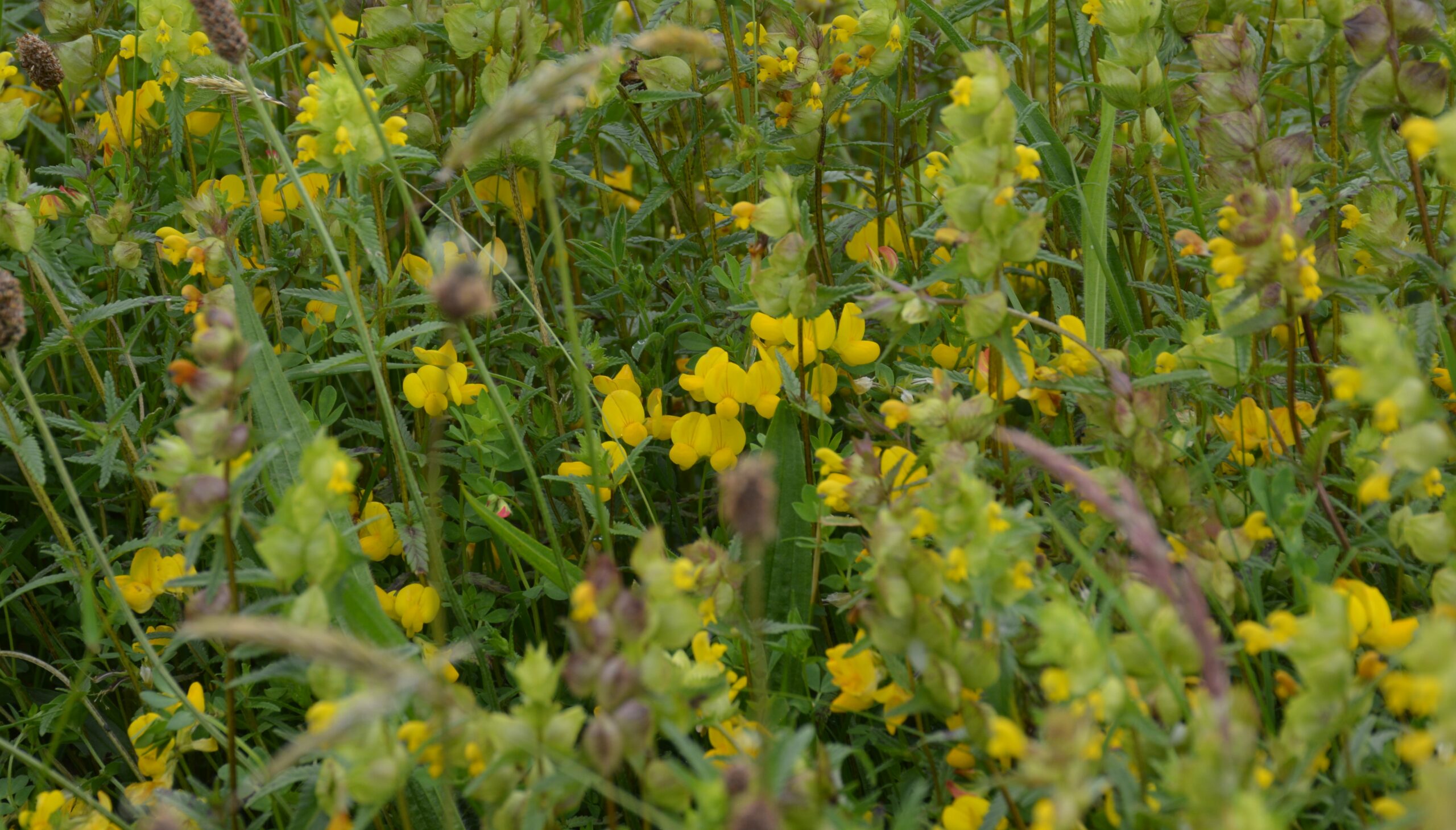This is an adapted version of my poster, which is also available as a pdf or png. As with all my work on this site it is CC BY 4.0 (free for use/adaptation as long as I am credited).
The Meadow Maker
Yellow Rattle (Rhinanthus minor) has become well known in restoration ecology and wildlife gardening as a “meadow maker”, which can transform a species-poor patch of grasses into a biodiverse and flower-rich one. What is it, and how does it change grasslands?
Yellow Rattle is an annual plant in the broomrape family (Orobanchaceae). Like most plants in the family, it is a parasite, latching on to the roots of other plants to steal water and nutrients. It is a hemiparasite, which means that it still makes its own carbohydrates via photosynthesis. It is also a facultative parasite, meaning it can survive on its own, though it grows much better with a host, and usually parasitises several at once1.
How it works

Yellow Rattle latches on to the roots of other plant species, forming an organ called the haustorium (Fig. 1). It penetrates the host root, using enzymes to break the tissue down2. Vascular tissue (water- and nutrient-carrying tubes) connects to the vascular tissue of the host root. It also keeps its stomata (the pores allowing water vapour to escape the leaves) wide open all the time. By letting water escape easily, it maintains a low water potential, meaning water from the host’s roots will tend to flow into the parasite’s roots, carrying nutrients with it too. It is essentially acting like a sponge.
This way it can steal around 20% of the nitrogen, phosphorus, potassium3 and water4 taken up by the host’s roots.
Some species like Oxeye Daisy and Ribwort Plantain can prevent the parasite forming connections at all⁵, so it cannot effectively steal nutrients from them. In Oxeye Daisy, the developing haustorium is blocked by a thickened layer of lignin; in Ribwort Plantain, the tissue surrounding the developing haustorium dies in order to prevent a connection being formed: a Hypersensitive Response2,5. In a growth experiment this meant the parasite could only obtain 2.5% of the nitrogen taken up by Oxeye Daisy, and 0.2% in Ribwort Plantain5.
Winners and Losers

Graph from a population dynamics model based on Cameron et al. (2009)6.
When Yellow Rattle is introduced to a grassland, it usually rapidly proliferates. This is because there are lots of good host plants, particularly large grasses, so plants grow large and produce lots of seeds.
Parasitism reduces the growth of the host plants. Species such as Yorkshire Fog and Cock’s Foot (both grasses) decline. This is the response conservationists are usually aiming for – a decline in grasses.
Yellow Rattle also declines as there are less hosts, and other species fill in the gaps. The decrease in grasses reduces competition for light, favouring smaller, less competitive species. Particularly those species which are less vulnerable to parasitism tend to increase, such as Ribwort Plantain, Common Spotted Orchid, and Sweet Vernal Grass.
References
1. Westbury 2004 J. Ecol. 92: 906-927
2. Cameron et al. 2006 Ann. Bot. 98: 1289-1299
3. Jiang et al. 2004 Funct. Plant. Biol. 31: 633-643
4. Jiang et al. 2003 J. Exp. Bot. 54: 1985-1993
5. Cameron & Seel 2007 New Phytol. 174: 412-419
6. Cameron et al. 2009 J. Ecol. 97: 1311-1319

Leave a Reply